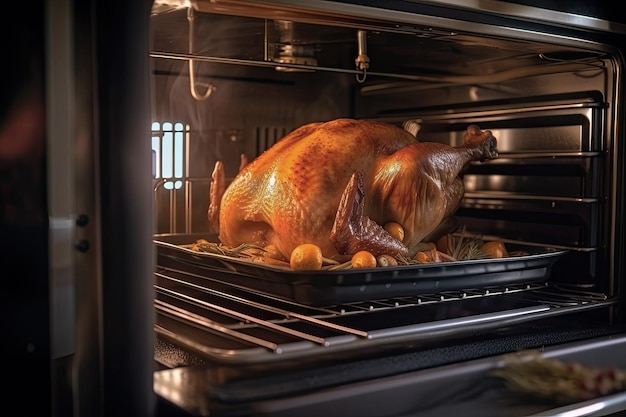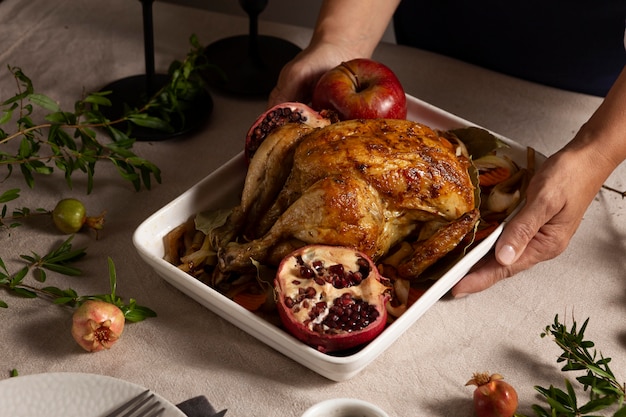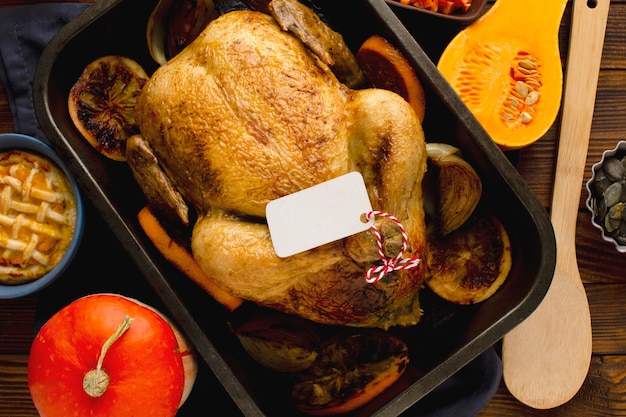Alright, let's talk about oven chicken. Who doesn't love a perfectly roasted bird? It's a classic, a crowd-pleaser, and honestly, just a darn good meal. But figuring out the right cooking time can feel like a recipe for disaster. No one wants dry, overcooked chicken, and nobody wants to take a chance on a raw center! So, grab a cuppa, settle in, and let's dive into the world of oven chicken cooking times together. I've got you covered!
Part 1: Understanding the Basics

First things first, let's get the fundamentals out of the way. cooking chicken in the oven isn't just about tossing it in and hoping for the best. There are a few key things that determine how long your chicken needs to cook. Think of it like a little chicken-cooking equation.
1. The Size of the Chicken: Big Bird, Big Time
This one's pretty straightforward. A larger chicken simply takes longer to cook than a smaller one. It's all about volume, my friends! A 1.5kg chicken will need a longer cooking time than a 1kg chicken. So, if you're dealing with a real whopper, be prepared to let it cook a bit longer.
2. Oven Temperature: Heat Makes the Difference
This is where things get a little more interesting. The hotter your oven, the faster your chicken will cook. Now, a typical oven temperature for chicken is 180°C/350°F/Gas Mark 4, but we'll get into more detail about specific temperatures later on. Just remember, if you crank up the heat, you'll shorten the cooking time.
3. The Cut of Chicken: Breasts, Thighs, and Everything in Between
We're not just talking whole chickens here. There's a whole world of chicken parts out there, each with its own cooking time. Chicken legs, breasts, thighs, wings – they all cook differently. Later, we'll break down the cooking times for each cut, so you can become a true chicken-cooking master.
4. The Method of Cooking: It's All in the Approach
Are you roasting a whole chicken, or are you going for individual pieces? Are you using a roasting pan, or a baking tray? Even the method you choose can affect the overall cooking time. For example, a whole chicken in a roasting pan might take longer than individual pieces on a baking sheet. Stay tuned, we'll explore these nuances as we go along.
So, there you have it! Those are the major factors that influence oven chicken cooking time. Now, let's dive into the specific details, starting with the classic: whole chicken.
Part 2: Whole Chicken Cooking Times

Ah, the humble roast chicken! A true culinary classic. Let's break down the cooking times for whole chickens, starting with the most important factor - the weight. We're going to be talking about average cooking times here, but remember, every oven is different.
1. 1-1.5kg Chicken: The Average Joe
For a small to medium-sized chicken, expect to cook it for about 1 hour and 15 minutes to 1 hour and 30 minutes at 180°C/350°F/Gas Mark 4. That's enough time for you to relax with a good book or catch up on your favourite TV show.
2. 1.5-2kg Chicken: The Heavyweight Champ
For a larger chicken, add about 15-20 minutes to the cooking time. That's roughly 1 hour and 30 minutes to 1 hour and 50 minutes. You'll need a bit more patience for this one, but it'll be worth it in the end.
3. Over 2kg Chicken: The Giant of the Roost
If you're dealing with a real whopper, you'll need to add another 15-20 minutes to the cooking time. That brings us to around 1 hour and 50 minutes to 2 hours and 10 minutes. This is a serious commitment, but I promise, it'll be worth the wait.
Remember, these are just guidelines, not hard and fast rules. Always check the internal temperature of the chicken with a meat thermometer to be sure it's cooked through. An internal temperature of 74°C/165°F is your goal. And hey, if you're feeling adventurous, you can always experiment with different oven temperatures and cooking times to find your perfect roast chicken.
Part 3: chicken pieces Cooking Times

Now, let's move on to chicken pieces. We're talking breasts, thighs, legs, wings – the whole shebang. Each cut has its own quirks when it comes to cooking time, so pay close attention!
1. chicken breasts: Quick and Easy
Chicken breasts are a popular choice for their versatility, and they cook relatively quickly, especially if you're dealing with boneless, skinless breasts. At 180°C/350°F/Gas Mark 4, they should take around 20-25 minutes. Boneless and skin-on breasts might take a little longer, around 30 minutes. Just keep a close eye on them, as they can go from perfectly cooked to dry in a flash.
2. chicken thighs: More Forgiving, More Flavorful
Chicken thighs are a bit more forgiving than breasts because they have a bit more fat, which helps to keep them moist. They take a little longer to cook, around 30-40 minutes at 180°C/350°F/Gas Mark 4. You can also cook thighs at a lower temperature for a more tender result. Try 160°C/325°F/Gas Mark 3 for a super juicy and tender result.
3. Chicken Legs: The Ultimate comfort food
Chicken legs, which include the thigh and drumstick, are similar to chicken thighs in terms of cooking time. You're looking at around 30-40 minutes at 180°C/350°F/Gas Mark 4. Chicken legs are great for a hearty meal.
4. chicken wings: Party Time
Chicken wings are usually cooked at a slightly higher temperature, around 200°C/400°F/Gas Mark 6. They should take around 30-40 minutes, depending on whether they are drumettes or wings. This is where things get a little more fun. You can toss your wings in your favourite sauce and bake them until they're crispy and delicious!
As with whole chicken, always check the internal temperature of the chicken pieces using a meat thermometer. You're aiming for an internal temperature of 74°C/165°F.
Part 4: Tips for perfect oven chicken
Alright, so we've covered the basics of oven chicken cooking times. Now, let's talk about some tips and tricks to ensure your chicken is cooked to perfection, juicy, flavorful, and absolutely delicious.
1. Brine It! The Secret to tender chicken
A simple brine can really make a difference in the tenderness and flavour of your chicken. It's like a spa day for your chicken, but way tastier. Simply soak your chicken in a mixture of salt, sugar, and water for a few hours before cooking. This will help to retain moisture and add a delicious flavour. You can use a simple salt and water brine, or get fancy with herbs, spices, or even citrus.
2. Pat It Dry! For crispy skin
Before you pop your chicken in the oven, make sure to pat it dry with paper towels. This will help to ensure the skin gets nice and crispy. No one wants soggy skin, right? So, give it a good pat dry, and get ready for some beautiful, crispy skin.
3. Get a Thermometer! Your Chicken's Best Friend
As I mentioned earlier, a meat thermometer is your best friend when it comes to oven chicken. It's the only way to be sure your chicken is cooked through and safe to eat. Don't rely on just looking at the chicken – get a thermometer and check that internal temperature!
4. Rest It! For Juicier, More Tender Chicken
Once your chicken is cooked, let it rest for 10-15 minutes before carving. This will allow the juices to redistribute, resulting in a juicier, more tender chicken. It's a simple step, but it makes a huge difference. Think of it as a little reward for the chicken after its journey in the oven.
Part 5: Oven chicken recipes
Now, let's move on to some delicious oven chicken recipes. These are my personal favourites, and they're sure to impress your family and friends.
1. Classic Roast Chicken with Lemon and Herbs: A Timeless Classic
This is a simple yet elegant recipe that never fails to please. Simply rub your chicken with a mixture of lemon zest, herbs like rosemary and thyme, salt, and pepper. Roast it until golden brown and cooked through. Serve with roasted vegetables and gravy for a truly satisfying meal. It's a perfect Sunday dinner option, and it's guaranteed to leave you feeling satisfied and happy.
2. Spiced Moroccan Chicken: A Flavorful Adventure
For a flavour explosion, try this spiced Moroccan chicken. Marinate your chicken in a mixture of cumin, coriander, paprika, ginger, garlic, and a touch of cinnamon. Then, roast it until golden brown and tender. Serve with couscous, dried fruit, and toasted almonds for a truly authentic Moroccan experience. It's a wonderful way to explore new flavours and spice up your dinner routine.
3. Honey Garlic Chicken: Sweet and Savory Goodness
This recipe is a crowd-pleaser, especially with kids. Simply glaze your chicken with a mixture of honey, soy sauce, garlic, and ginger. Roast it until the glaze is caramelized and the chicken is cooked through. Serve with rice or noodles. It's a sweet and savory dish that everyone will love.
Part 6: Oven Chicken Cooking Times Table
To make things a bit easier, here’s a handy table summarizing oven chicken cooking times for various cuts and weights. This is your cheat sheet for perfect oven chicken!
| Cut | Weight (kg) | Cooking Time (minutes) | Temperature (°C/°F/Gas Mark) |
|---|---|---|---|
| Whole Chicken | 1-1.5 | 75-90 | 180/350/4 |
| Whole Chicken | 1.5-2 | 90-110 | 180/350/4 |
| Whole Chicken | Over 2 | 110-130 | 180/350/4 |
| Chicken Breast (boneless, skinless) | - | 20-25 | 180/350/4 |
| Chicken Breast (boneless, skin-on) | - | 30 | 180/350/4 |
| Chicken Thigh | - | 30-40 | 180/350/4 |
| Chicken Leg | - | 30-40 | 180/350/4 |
| Chicken Wing (drumettes) | - | 30-40 | 200/400/6 |
| Chicken Wing (wings) | - | 30-40 | 200/400/6 |
Remember, these are just general guidelines. It's always best to check the internal temperature of your chicken using a meat thermometer to ensure it is cooked through.
Part 7: Oven Chicken Troubleshooting
Even the most seasoned cooks can encounter a few hiccups in the oven chicken game. Here are some common issues and how to deal with them. Don't worry, we've all been there!
1. Dry Chicken: The Curse of Overcooked Chicken
Dry chicken is a common issue, especially with larger birds. If you’re concerned about dryness, try brining your chicken, basting it regularly during cooking, or using a higher fat content, like chicken thighs. You can also use a pan of water underneath the chicken to keep the air moist. The key is to keep the moisture locked in.
2. undercooked chicken: Safety First
This is a serious issue, so always make sure your chicken is cooked through. If you suspect your chicken is undercooked, it's best to cook it for a little longer. Check the internal temperature with a meat thermometer to be sure. Don't take any chances when it comes to food safety.
3. Burned Chicken: A Crispy Skin Gone Wrong
If your chicken is starting to burn, reduce the oven temperature or cover it loosely with foil for the remaining cooking time. You can also try flipping the chicken over to ensure even browning. Sometimes, a little extra care is needed to prevent that burnt-to-a-crisp look.
Part 8: FAQs
Let's tackle some of the most common questions about oven chicken cooking times.
1. How do I know if my chicken is cooked through?
The best way to know if your chicken is cooked through is to use a meat thermometer. The internal temperature should be at least 74°C/165°F. If you don't have a meat thermometer, you can check for doneness by poking the thickest part of the chicken with a fork. If the juices run clear, it's cooked through. If the juices are still pink, it needs to cook longer.
2. What if I overcook my chicken?
Overcooked chicken can be a bit dry, but it's still safe to eat. If your chicken is a bit too dry, you can add some moisture back in by basting it with a little bit of butter or pan juices. You can also try serving it with a sauce to add some extra flavour and moisture.
3. How long can I keep cooked chicken in the fridge?
Cooked chicken can be kept in the fridge for up to three days. Make sure you store it in an airtight container or wrap it tightly in plastic wrap. This will help to keep it fresh and prevent any unwanted flavours from transferring.
4. Can I freeze cooked chicken?
Yes, you can freeze cooked chicken for up to two months. Just wrap it tightly in plastic wrap and then place it in a freezer-safe bag. When you're ready to eat it, thaw it in the refrigerator overnight. It's a great way to save leftovers and have a quick meal ready when you need it.
5. What are some good ways to use leftover chicken?
There are endless possibilities for leftover chicken! You can use it in salads, sandwiches, soups, stir-fries, or even make chicken pot pie. Get creative and have fun with it! Leftover chicken is a versatile ingredient that can be used in so many different ways.
Well, there you have it - the ultimate guide to oven chicken cooking times. Now you have all the information you need to cook delicious and juicy chicken every time. Happy cooking, my friends!
Everyone is watching

How to Cook Frozen Lobster Tails Perfectly: A Step-by-Step Guide
RecipesLobster. Just the word conjures up images of lavish meals, special occasions, and a taste of luxury. But let's...

Pigs in a Blanket Cooking Time: How Long to Bake for Perfect Results
RecipesAh, pigs in a blanket. Just the name conjures up images of those delightful little parcels of crispy pastry en...

Pork Fillet Cooking Time: How Long to Cook It Perfectly
RecipesPork fillet, or tenderloin as it's sometimes called, is a real favourite in our house. It's so versatile, and...

The Ultimate Guide to Cooking Delicious Frankfurters
RecipesLet's face it, we all love a good frankfurter. It's a classic, simple, and always satisfying. But let's be rea...

Wolf Meat Recipes: A Guide to Cooking Wild Game
RecipesLet's be honest, you don't see wolf meat at your local butcher shop every day. It's a bit of a wild card, but ...
